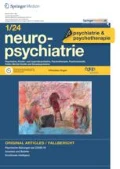Zusammenfassung
Anliegen
Das Multidimensionale Inventar zum Religiös/Spirituellen Befinden (MI-RSB) wurde in mehreren klinischen und non-klinischen Studien erfolgreich angewendet. Allerdings erwies sich die MI-RSB Originalversion mit 48 Items im Speziellen für klinische Fragestellungen oft als zu umfangreich. Ziel dieser Arbeit ist deshalb die Entwicklung einer adäquaten MI-RSB Kurzversion mit 12 Items.
Methode
Anhand einer für die österreichische Allgemeinbevölkerung (N = 1500) repräsentativen Stichprobe wird mittels Faktoren- bzw. Reliabilitätsanalyse eine erste MI-RSB Kurzversion erstellt. Des Weiteren wird die neue Version der Skala mittels verschiedener Indikatoren von psychischer Erkrankung erstmals validiert.
Ergebnisse
Das MI-RSB überzeugt auch in der Kurzversion durch seine psychometrischen Eigenschaften. Die Gesamtskala und die Subskalen erweisen sich als zumindest ausreichend reliabel. Auch für die Kurzversion der MI-RSB Skala zeigen sich signifikant negative Zusammenhänge mit verschiedenen Parametern psychiatrischer Erkrankung.
Schlussfolgerungen
Die MI-RSB 12 Skala kann vor allem zur weiteren Beforschung der klinischen Relevanz von Religiosität und Spiritualität herangezogen werden.
Summary
Objective
The Multidimensional Inventory for Religious/Spiritual Well-Being (MI-RSWB) was successfully applied in several clinical as well as non-clinical studies. However, the original version of the scale often showed to be as too comprehensive especially for clinical surroundings. There for the aim of this study is to develop a short version of the scale comprising 12 items.
Method
Based on a sample representative of the Austrian general population (N = 1,500), a first MI-RSWB short version is developed by means of factor- and reliability analysis. Furthermore the new short version of the scale is initially validated through several indicators of mental illness.
Results
The MI-RSWB short version shows convincing psychometric properties. The total scale as well as the sub scales exhibit at least a sufficient internal consistency. A significant negative association with several indicators of psychiatric illness is also confirmed for the short version of the scale.
Conclusions
The MI-RWSB 12 scale is especially recommended for further research focusing on the clinical relevance of religiosity and spirituality.
Literatur
Bortz J. Statistik für Sozialwissenschaftler. Berlin:Springer; 2001.
Cook CC. Addiction and spirituality. Addiction. 2004;99:539–51.
Dein S, Cook CC, Koenig H. Religion, spirituality, and mental health: current controversies and future directions. J Nerv Ment Dis. 2012;10:852–5.
Dervic K, Oquendo MA, Grunebaum MF, Ellis S, Burke AK, Mann JJ. Religious affiliation and suicide attempt. Am J Psychiatry. 2004;161:2303–8.
Dilling H, Mombour W, Schmidt MH, Schulte-Markwort E, Herausgeber. Internationale Klassifikation psychischer Störungen: ICD 10, Kapitel VII (F): Psychische und Verhaltensstörungen. Bern:Huber; 1994.
Franke GH. Brief symptom inventory von L.R. Derogatis (Kurzversion der SCL-90-R)-Deutsche Version. Göttingen: Beltz Test GmbH; 2000.
Hautzinger M, Bailer M, Worall H, Keller F. Beck-Depressions-Inventar. Bern:Huber; 1994.
Hedderich J, Sachs L. Angewandte Statistik. 14. Aufl. Berlin:Springer; 2012.
James W. Die Vielfalt religiöser Erfahrung. Olten: Walter Verlag; 1979 (Original erschienen 1902: The varieties of religious experience).
Kämmerle M, Dahmen-Wassenberg P, Fink A, Unterrainer HF. Dimensions of religious/spiritual well-being and the dark side of personality, submitted; 2013.
Kendler KS, Liu XQ, Gardner CO, McCullough ME, Larson D, Prescott CA. Dimensions of religiosity and their relationship to lifetime psychiatric and substance use disorders. Am J Psychiatry. 2003;160:496–503.
Lamba G, Ellison JM. Religion/spirituality and depression. Am J Psychiatry. 2012;169:433.
Lienert GA, Raatz A. Testaufbau und Testanalyse. Weinheim: PVU; 1994 (Original erschienen 1961).
Mohr S, Brandt PY, Borras L, Gilliéron C, Huguelet P. Toward an integration of spirituality and religiousness into the psychosocial dimension of schizophrenia. Am J Psychiatry. 2006;163:1952–9.
Pargament KI. The psychology of religion and spirituality? Yes and no. Int J Psychol Relig. 1999;9:3–16.
Rippentrop EA, Altmaier EM, Chen JJ, Found EM, Keffala VJ. The relationship between religion/spirituality and physical health, mental health, and pain in a chronic pain population. Pain. 2005;116:311–21.
Sloan RP, Bagiella E, Powell T. Religion, spirituality, and medicine. Lancet. 1999;353:664–7.
Smith TB, McCullough ME, Poll J. Religiousness and depression: evidence for a main effect and the moderating influence of stressful life events. Psychol Bull. 2003;129:614–36.
Unterrainer HF, Fink A. Das Multidimensionale Inventar zum religiös-spirituellen Befinden (MI-RSB): Normwerte für die österreichische Allgemeinbevölkerung. Diagnostica. 2013;1:33–44.
Unterrainer HF, Huber HP, Ladenhauf KH, Wallner SJ, Liebmann PM. MI-RSB 48. Die Entwicklung eines multidimensionalen Inventars zum religiös-spirituellen Befinden. Diagnostica. 2010;2:82–93.
Unterrainer HF, Huber HP, Sorgo IM, Collicutt J, Fink A. Dimensions of religious/spiritual well-being and schizotypal personality. Pers Indiv Diff. 2010;51:360–4.
Unterrainer HF, Ladenhauf KH, Wallner SJ, Fink A. Dimensions of religious/spiritual well-being and its relation to personality and psychological well-being. Pers Indiv Diff. 2010;49:192–7.
Unterrainer HF, Lewis AJ, Fink A. Religious/spiritual well-being, personality and mental health: a review of results and conceptual issues. J Relig Health. 2012. doi:10.1007/s10943-012-9642-5.
Unterrainer HF, Schöggl H, Lewis AJ, Fink A, Weiss EM, Kapfhammer H-P. Religiös/Spirituelles Befinden bei psychisch Kranken: Ängstlich/Depressive und Suchtkranke im Vergleich zu gesunden Kontrollpersonen. Neuropsychiatrie. 2013. doi:10.1007/s40211-013-0075-5.
Interessenkonflikt
Die Autoren Human-Friedrich Unterrainer und Hans-Peter Kapfhammer erklären hiermit keinerlei Interessenkonflikt.
Author information
Authors and Affiliations
Corresponding author
Rights and permissions
About this article
Cite this article
Unterrainer, HF., Kapfhammer, HP. Religiös/Spirituelles Befinden bei psychisch Kranken II: Die Entwicklung einer Kurzskala und Vergleichswerte von klinisch-psychiatrischen Gruppen und gesunden Kontrollpersonen. Neuropsychiatr 28, 49–55 (2014). https://doi.org/10.1007/s40211-013-0083-5
Received:
Accepted:
Published:
Issue Date:
DOI: https://doi.org/10.1007/s40211-013-0083-5

